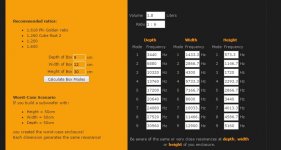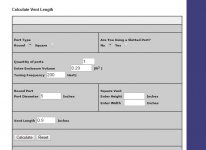This project is about creating better enclosures for the 3.5 inch speaker drivers that came with my PC speaker system that was converted to an amplifer in this thread:
http://www.diyaudio.com/forums/chip-amps/283845-pc-speaker-electronics-amplifier-conversion.html
Removing the 3-inch speaker drivers and testing them externally yielded some interesting and encouraging results. Placing them in cardboard boxes generated a surprising level of clarity and some semblance of bass.
The speakers do sound better when 'liberated' from their enclosures. There are several reasons for this, as far as I am able to ascertain. The speaker grille probably cause a lot of diffraction, and also resonances. The box formed by the front of the speaker enclosure and the speaker box also causes some level of 'boxiness' and resonance.
I hope to design and build speaker enclosures for the speakers.
Specifications:
Impedance: 4 Ohms
Power Handing : 3 Watts
Size : 3 inches
Measurements:
Frequency response : 100Hz to 12,000 Hz (pure tone)
Max output : 75 dB at 1 metre
http://www.diyaudio.com/forums/chip-amps/283845-pc-speaker-electronics-amplifier-conversion.html
Removing the 3-inch speaker drivers and testing them externally yielded some interesting and encouraging results. Placing them in cardboard boxes generated a surprising level of clarity and some semblance of bass.
The speakers do sound better when 'liberated' from their enclosures. There are several reasons for this, as far as I am able to ascertain. The speaker grille probably cause a lot of diffraction, and also resonances. The box formed by the front of the speaker enclosure and the speaker box also causes some level of 'boxiness' and resonance.
I hope to design and build speaker enclosures for the speakers.
Specifications:
Impedance: 4 Ohms
Power Handing : 3 Watts
Size : 3 inches
Measurements:
Frequency response : 100Hz to 12,000 Hz (pure tone)
Max output : 75 dB at 1 metre
Last edited:
Passive Radiator
This speaker system is planned as a a two- driver system with a passive resonator in the bottom section.
In any case the enclosure acts as a resonator here.
Something along the lines of the design outlined here:
http://www.diyaudio.com/forums/full...er-full-range-line-array-180.html#post4613175
Where's the multy way attitude ?
This speaker system is planned as a a two- driver system with a passive resonator in the bottom section.
In any case the enclosure acts as a resonator here.
Something along the lines of the design outlined here:
http://www.diyaudio.com/forums/full...er-full-range-line-array-180.html#post4613175
Completed the corrugated card enclosure. While the sound is still clear, I don't see an increase in bass response compared to the earlier 1 litre cardboard box. I will be therefore building a 1 litre enclosure with the passive port at the bottom.
For comparison, here are some corrugated cardboard speakers:
OrigAudio Hits It Big With Fold and Play Recycled Speakers
http://www.diyaudio.com/forums/multi-way/184805-corrugate-speakers-aka-cardboard.html
For comparison, here are some corrugated cardboard speakers:
OrigAudio Hits It Big With Fold and Play Recycled Speakers
http://www.diyaudio.com/forums/multi-way/184805-corrugate-speakers-aka-cardboard.html
Pictures of Drivers and test enclosure
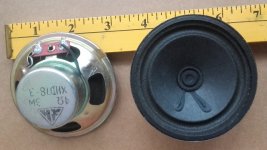
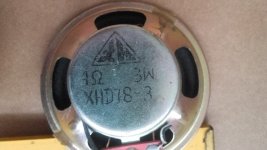
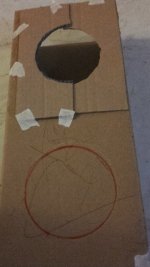
Pictures of the speaker drivers. These are small units, about 3 inches across and capable of all of 3 Watts.
I have attached them to a cardboard box and cut a port of equal size underneath the speaker.
First tests were amazing. Clear sound from the drivers now freed of their cage, and the bass port generated audible, if not sufficient bass. A huge improvement over the original.
I am now convinced of the effects of a ported enclosure, so how do I proceed?
This calculator gives a list of resonant frequencies - do I need to make the box larger?
This calculator gives the port length, is this more or less OK?
Next attempt will be with plywood or hardboard since the proof of concept works it will only sound better in a stiffer enclosure?
Any suggestions?



Pictures of the speaker drivers. These are small units, about 3 inches across and capable of all of 3 Watts.
I have attached them to a cardboard box and cut a port of equal size underneath the speaker.
First tests were amazing. Clear sound from the drivers now freed of their cage, and the bass port generated audible, if not sufficient bass. A huge improvement over the original.
I am now convinced of the effects of a ported enclosure, so how do I proceed?
This calculator gives a list of resonant frequencies - do I need to make the box larger?
This calculator gives the port length, is this more or less OK?
Next attempt will be with plywood or hardboard since the proof of concept works it will only sound better in a stiffer enclosure?
Any suggestions?
Last edited:
Online calculator results
The first site gives a list of freqencies, they are all different for L W and H. This seems OK, however. If I make the box larger I can get the frequencies lower so I get more bass, is this how it work?
For the size of the box, 0.0635 cu ft, I get the result of 1.84 vent lenght for 2 inch diameter port. "Tuning frequency" is the required frequency? Time to experiment.
The first site gives a list of freqencies, they are all different for L W and H. This seems OK, however. If I make the box larger I can get the frequencies lower so I get more bass, is this how it work?
For the size of the box, 0.0635 cu ft, I get the result of 1.84 vent lenght for 2 inch diameter port. "Tuning frequency" is the required frequency? Time to experiment.
Attachments
Last edited:
Without at least knowing its Fs and effective piston dia. or area [Sd], choosing a cab alignment is a crap shoot at best.
Yes, 'BIB' [bigger is better] rules when trying to get the most bass out of a driver. Tuning frequency is F-box [Fb], i.e. the frequency it's tuned to, which normally would be > Fs if Qts is <~0.403 [Fs tuning] and < Fs for > ~0.403 Qts, but if you don't know what it is, then all you can do is experiment with vent length to find the flattest response and if it isn't flat enough with just a hole in the baffle, then you have to use a larger tube and start over; and if the bass is still too lean, then start over with a larger cab.
Odds are though is that the driver has as high as a 250 Hz Fs with a very high Qts, so the only viable vented alignment is a stuffed TL if the latter is true.
GM
Yes, 'BIB' [bigger is better] rules when trying to get the most bass out of a driver. Tuning frequency is F-box [Fb], i.e. the frequency it's tuned to, which normally would be > Fs if Qts is <~0.403 [Fs tuning] and < Fs for > ~0.403 Qts, but if you don't know what it is, then all you can do is experiment with vent length to find the flattest response and if it isn't flat enough with just a hole in the baffle, then you have to use a larger tube and start over; and if the bass is still too lean, then start over with a larger cab.
Odds are though is that the driver has as high as a 250 Hz Fs with a very high Qts, so the only viable vented alignment is a stuffed TL if the latter is true.
GM
Couldn't I figure out FS by using a sine wave input and find the frequency at which the highest DB output is measured? The definitions for Fs I have not found very useful.
Cheap speakers are useful for something:
The Cheap Speaker Test | The Recording RevolutionThe biggest strength and weakness of cheap speakers is their over abundance of midrange frequencies. They have very little bass response and many times muted top end.What that leaves you is an exposed mid section (yikes!).
Couldn't I figure out FS by using a sine wave input and find the frequency at which the highest DB output is measured? The definitions for Fs I have not found very useful.
Don't see why not, but have never tried it, so not sure if there's any specific considerations. Historically, it's measured with a voltmeter, resistor, frequency generator: Measuring Loudspeaker Driver Parameters
GM
Another option is using a passive radiator:
Much too large, heavy for a high Fs 3.5" driver.
GM
Cheap speakers are useful for something:
Absolutely! Normally best used as a wide BW mids/lower treble of a three way to cover at least the critical 'telephone' BW.
GM
Yes, so the critical BW would be 400 to 3000 Hz? Best used without a crossover for the mid range? The ones I am using have absolutley no crossover and whatever speakers I use without crossover it seem to sound clearer and more natural.
Well, it's 250-2500 Hz for analog phones and 300-3000 Hz for digital, so 250-3000 Hz with an octave of flat response on either side as a buffer of sorts to isolate XOs = 125-6000 Hz and use 2nd order.
GM
GM
Hardboard material
Switched my building material to hardboard, costing less than $1 equivalent for a 50 cm by 150 cm piece.
A hole saw attachment made cutting holes for the speakers easy.
Initial testing showed acceptable sound - without completing the back panels yet. I was concerned about unnecessary coloration of the sound, not knowing how the new material would react, but it turned out OK. I can always add more layers to damp the sound.
Seems like a cheap material all over the world.
Easy to cut as well, and layering will be stiffer because of the multiple skins in the layer. Let's say it highlighted the need for improving my woodworking skills.
Switched my building material to hardboard, costing less than $1 equivalent for a 50 cm by 150 cm piece.
A hole saw attachment made cutting holes for the speakers easy.
Initial testing showed acceptable sound - without completing the back panels yet. I was concerned about unnecessary coloration of the sound, not knowing how the new material would react, but it turned out OK. I can always add more layers to damp the sound.
Seems like a cheap material all over the world.
Easy to cut as well, and layering will be stiffer because of the multiple skins in the layer. Let's say it highlighted the need for improving my woodworking skills.
Need more bass
My prototype speakers are up and running, and working well enough. Clarity is as good as I would want, but I am havng problems with getting adequate bass.
Whippining out my Android phone, I did a frequency sweep from about 10,000 Hz to 45 Hz. The high end does not concern me here, but the sound levels dropped off abrubtly at about 135 Hz.
Testing with the car audio system, which has adequate bass, showed that the audible frequency response goes down to 65 Hz or so. A casual glance at speaker specs shows that bookshelf speakers are rated at 40 to 50 Hz upwards in frequency response.
Assuming that the sine wave test will show if a speaker is capable of producing a decent bass and drums in music, how do I increase the bass output? I can feel the little 3 inch driver putting out this frequency but it needs to be captured and mechanically amplified.
My cabinet is approx. 12 cm by 8 cm by 30 cm in size. It is fully sealed as I can manage with initial sloppy construction. The books say 0.29 cubic feet or 7 litres is needed for an enclosure for this driver size. Will a port help without increasing the size? I need to aim for a 50-75 Hz tuning frequency, is that correct?
Is more bass gaurateed with a larger cabinet or does it depend on the ratio of the sides? I prefer the speakers to be less than 10 cm deep.
My prototype speakers are up and running, and working well enough. Clarity is as good as I would want, but I am havng problems with getting adequate bass.
Whippining out my Android phone, I did a frequency sweep from about 10,000 Hz to 45 Hz. The high end does not concern me here, but the sound levels dropped off abrubtly at about 135 Hz.
Testing with the car audio system, which has adequate bass, showed that the audible frequency response goes down to 65 Hz or so. A casual glance at speaker specs shows that bookshelf speakers are rated at 40 to 50 Hz upwards in frequency response.
Assuming that the sine wave test will show if a speaker is capable of producing a decent bass and drums in music, how do I increase the bass output? I can feel the little 3 inch driver putting out this frequency but it needs to be captured and mechanically amplified.
My cabinet is approx. 12 cm by 8 cm by 30 cm in size. It is fully sealed as I can manage with initial sloppy construction. The books say 0.29 cubic feet or 7 litres is needed for an enclosure for this driver size. Will a port help without increasing the size? I need to aim for a 50-75 Hz tuning frequency, is that correct?
Is more bass gaurateed with a larger cabinet or does it depend on the ratio of the sides? I prefer the speakers to be less than 10 cm deep.
According to the 2cm by 4 cm port is needed for 75 Hz according to this site.
Not sure about square or slotted ports.
Not sure about square or slotted ports.
- Home
- Loudspeakers
- Multi-Way
- New enclosures for PC speakers -

